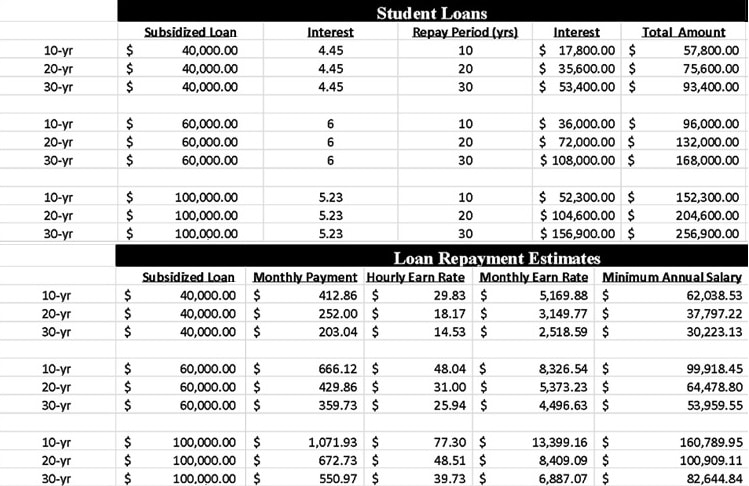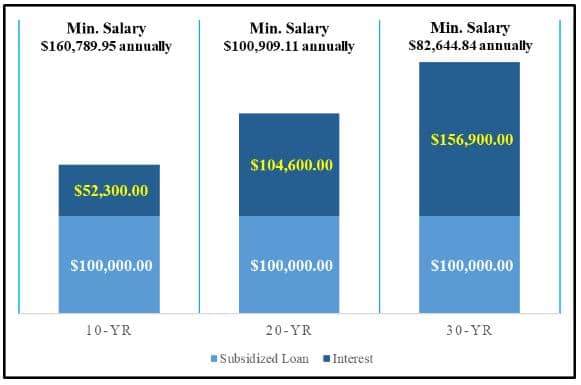By Amyn Amlani, PhD
According to a recent Forbes report,1 US student loan debt is the second-ranked consumer commitment, trailing only mortgage debt. Several factors2 contribute to the rising costs associated with higher education, such as the cost of instruction (but not faculty salaries), operation and maintenance, student services, and research.
For graduate students enrolled in a professional audiology program and for those professionals that recently received their Doctor of Audiology (AuD) degrees, the ability to re-pay student loan debt could mean the difference between professional longevity and professional attrition. This dilemma is well established and supported by facts such as:
- 41% of graduating audiologist who earn a Master’s degree leave the profession within a decade of graduation;3
- 44% of AuD students question why they are choosing audiology as their profession;4
- Roughly 20% of students enrolled in an AuD program drop-out prior to degree completion;5 and
- Roughly one-third of graduate admissions offer funding to incoming students6
In this month’s blog, an example of student loan debt has been created, along with corresponding loan repayment estimates. Data from this example is then compared to mean salaries from other professions.
Hypothetical Example
Table 1 highlights assumes that a hypothetical student was granted subsidized loans only for four years of undergraduate studies (i.e., $40,000 debt) and four years of graduate audiology studies (i.e., $60,000 debt). Interest rates during undergraduate and graduate studies is 4.45% and 6%, respectively, or 5.23% combined. The rationale to use $100,000 in student debt was reported by Gaffney.7

Table 1: Hypothetical example of student loan debt accrued over an 8-year period (i.e., 4-years of undergraduate education; 4-year professional education). The example also estimates repayment estimates over a 10-, 20-, and 30-year period, along with the minimum annual salary required to repay the student debt.
The data shown in Table 1 are predicated on:
- Subsidized loans only, where the government pays interest while the student remains enrolled and in good standing;
- The model excludes additional expenses, such as administrative fees and loan origination fees;
- The interest rates are weighted accordingly given differences in undergraduate and graduate principle;
- Student repayment periods of 10-, 20-, and 30-years; and,
- Repayment values are capped at a debt-to-income ratio of < 8%.
Relationship Loan Repayment Estimates and Professional Salary
For borrowers of student loans, living within one’s means can become problematic. In our example, the student has earned both a bachelor and doctoral degree, but managed to rack up $100,000 in student loan debt. To pay off this debt, below are three standard options:
- If the student wanted to pay off this debt over a 10-year period, while retaining an 8% debt-to-income ratio, he/she would require a minimum annual salary of $160,789.95 for the next decade (Figure 1).
- If the student wanted to pay off this debt over a 20-year period, while retaining an 8% debt-to-income ratio, he/she would require a minimum annual salary of $100,909.11 for the next two decades (Figure 1).
- If the student wanted to pay off this debt over a 30-year period, while retaining an 8% debt-to-income ratio, he/she would require a minimum annual salary of $82,644.84 for the next three decades (Figure 1).

Figure 1. Student loan principal and interest for a 10-, 20-, and 30-year repayment plan, along with the minimum salary required for repayment at an 8% debt-to-income ratio.
A problem with these options is that the average audiology salary is markedly less than the amount of debt borrowed. According to the US Department of Labor, the average salary for an audiologist is $75,920 (i.e., $36.50 hourly; $6326.67 monthly).
With this average salary, and making minimum payments towards the $100,000 in student loan debt + 5.23% average interest at an 8% debt-to-income ratio, it would take the average audiologist roughly 38 years to pay back this loan.
This finding suggests a negative correlation between student education costs and professional outlook, and serves as a threat to professional growth.
Audiology Student Loan Debt Compared to Other Professions
Table 2 reports on the time needed to repay the same student loan debt compared to other professions’ average salaries.
Summary
If the profession of audiology is to meet the immediate and future needs of the US population that requires hearing healthcare, then action is required at many levels to circumvent the potential attrition that looms with the next generation of AuD graduates, many of whom will be burdened with a negative debt-to-income ratio.
It is incumbent on universities to find avenues that reduce the costs associated with higher education (e.g., graduate assistantships, three- versus four-year degree programs, credit hours to graduation). In addition, professional organizations should assess demand and supply needs within the public health domain and guide the profession with a revised strategic mission to ensure that the needs of the public and the profession are met.
A failure to assess the student loan debt issue now only entices new avenues of growth for other professions and new models of service delivery that excludes audiology.
References:
- Friedman, Z. (2018, June 13). Student loan dent statistics in 2018: A $1.5 trillion Crisis. https://www.forbes.com/sites/zackfriedman/2018/06/13/student-loan-debt-statistics-2018/#1c3c55e27310
- Adams, M. (2017, June 20). What contributes to rising college costs? https://www.eab.com/research-and-insights/facilities-forum/expert-insights/2017/factors-affecting-college-tuition
- Windmill, I.M., & Freeman, B.A. (2013). Demand for audiology Services: 30-year projections and impact on academic programs. J. American Academy of Audiology, 24, 5: 407-416.
- Bennett, H.N., & Steiger, J.R. (2009) Au.D. student attitudes toward the profession: a 2002 survey repeated in 2009. Audiol Today, 22(6):53–63.
- Higher Education Data Services (2013). Higher Education Data Systems (2013) https://www.asha.org/Academic/HES/Archived-HES-Data-Reports/
- https://www.asha.org/uploadedFiles/2013-2014-CSD-Education-Survey-National-Aggregate-Data-Report.pdf
- Gaffney, T. (2016). The rising cost of AuD education. https://hearinghealthmatters.org/hearinprivatepractice/2016/rising-cost-audiology-education-debt/








And yet the field drives onward. Some light could possibly come from past data, i.e. what was the similar data from 30-40 years ago. What changes occurred to make today’s data different?
Other suggestions or ideas about how to lay off costs of training also should be considered. The rub, of course, is how to lessen costs (debt) and still maintain (and increase) quality and relevance of the profession. This burden of salvation always seems to fall on educators who have their own set of problems.
The burden is on the profession as a whole—this issue has been a concern for many AuD students and grads since the requirement of the AuD as the entry level necessary for practice.
We’ve been saddling students with serious debt now for 10+yrs and yet the profession hasn’t really progressed in a substantial way as was promised with the new degree and making audiology a “doctoring profession”. Looking at the above analysis is yet more evidence that the AuD degree is doing more harm than good considering we have yet to expand our scope beyond what a masters degree offered.
I’m afraid attrition is inevitable unless audiology makes some big changes in the next 5-10yrs. Sad to say.
A couple of friends and I have always joked about suing the graduate programs to refund the cost of degrees. However, there is little reason to blame the universities. I think we can agree on the source of at least some of these problems. All of audiology leadership should be working on major solutions (most of which will be unwelcome by many).
It’s ironic that, as the field was transition to the AuD entry-level requirement (maybe 12-15 years ago) the field was very vigorously debating the merits of whether 3 year programs were sufficient enough for an AuD and back then only 1 or 2–controversially–were 3 years in length.
Today the trend is moving towards 3 years, and why not: many dentists only go to 3 year programs. Perhaps in another couple of years we’ll be debating an even shorter course length (due to costs) or whether we should admit people into programs with just 2 years of pre-audiology under their belts.
Whether we want to admit it or not, something’s gotta give. For audiology’s ability to thrive into the future, outside of the VA and Academia, we have to start coming up with some realistic solutions.
Yes. I have been burdened with 100k in student loans with a salary that is good but nowhere near what it should be to match the debt I’ve accumulated. And I’m very frustrated by the fighting, lack of unity, and different directions the multiple groups of professionalleadership that only seem to split audiologists further apart. Definitely wish I had chosen something different. Hopefully it pays off in the end. On another note, I do enjoy helping people hear again. #38years
Wow this is speaking right to me. I regretted my decision to go into audiology maybe 1 year into grad school. I nicely counsel anyone considering this field to go into something else. There are many other 4 year degrees that pay well above what audiologists make. Getting my doctorate in audiology was a poor investment.
Ditto Lindsay, well said. It’s not an unrewarding field, on the contrary, but one can not argue against the fact that an AuD degree is a very poor financial investment.
I’ve been out of my AuD program for over a decade and will still be paying off the remainder of my loan for at least 15 years. I was very naive to believe claims from some of the big AuD movement proponents back then stating wildly inaccurate wage data and claims about all the benefits of being a “doctor”. I also don’t encourage people to enter our field for this reason alone unless they have substantial scholarships and understand the financial reality. Become a PA, PT, OT or SLP, you can still help many people and be less burdened financially compared to audiology.
Thank you Dr. Amlani for shedding a well deserved light back on this issue. This should be required reading for anyone in audiology leadership.
Ohhh, it’s sad that there are spheres of education that are not becoming profitable and expensive. I do not know what will happen in the future, but for the time being I find the program AuD not expedient. I hope that this will improve, and new prospects for development will appear on the horizon. Especially in the age of digital technology, when every day new discoveries are made.